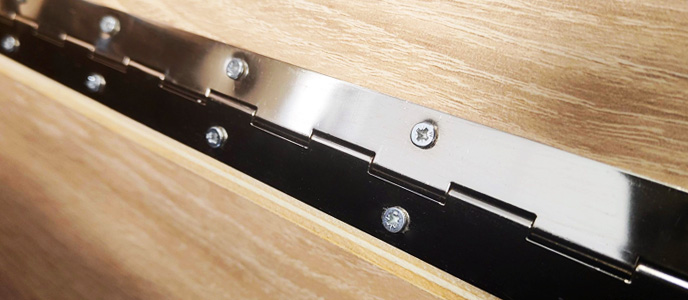
Are you a tradie with a piano in your house? Unless you're a budding classical musician, the answer is probably no. Yet, it’s likely you’ve heard of a piano hinge. You may use them frequently. They certainly are handy little components! Have you ever wondered why they’re called piano hinges? Let’s find out…
Where does the name piano hinge come from?
A piano hinge is a type of long hinge that is commonly used to attach lids or doors to boxes, canopies or other storage compartments. The name "piano hinge" comes from its original use in pianos.
Pianos have a lid that covers the soundboard and keys. To support this heavy lid while allowing it to be easily lifted and closed, a long and narrow hinge was used that ran the length of the lid. This hinge was similar in design to the modern piano hinge, with a series of interlocking leaves that were connected by a central pin.
Over time, the design of this hinge was adapted for use in other applications, and it became known as a piano hinge due to its association with pianos. Today, piano hinges are commonly used in a wide variety of industries, from furniture making to aerospace engineering, and are known for their strength, durability, and ability to support heavy loads.
What are the applications of a piano hinge?
Piano hinges have a wide range of applications and are commonly used in various industries. Some of the common applications of piano hinges include:
Furniture: Piano hinges are used to attach lids, doors, and panels to cabinets, chests, and other types of furniture.
Aerospace: Piano hinges are used in aerospace applications to attach access panels, doors, and other components.
Electronics: Piano hinges are used in electronic enclosures to attach covers and doors to the enclosure.
Construction: Piano hinges are used in construction to attach doors to cabinets, sheds, and other types of structures.
Industrial equipment: Piano hinges are used in industrial equipment to attach access panels, doors, and other components.
Marine: Piano hinges are used in marine applications to attach hatches, doors, and panels to boats and other watercraft.
Automotive: Piano hinges are used in automotive applications to attach doors, hoods, and trunk lids to vehicles.
Overall, piano hinges are versatile and can be used in many different applications where a long and narrow hinge is needed to support a heavy load. They are known for their strength, durability, and ability to distribute weight evenly along their length, making them a popular choice in various industries.
How do I use a piano hinge?
Here are the general steps to follow when using a piano hinge:
- Position the hinge: First, position the hinge in the location where you want to attach it. Make sure that the hinge is aligned straight and level.
- Mark the screw holes: Use a pencil or marker to mark the location of the screw holes on the hinge and the surface where it will be attached.
- Pre-drill the holes: Use a drill bit that is slightly smaller than the diameter of the screws to pre-drill the holes in the hinge and the surface where it will be attached.
- Attach the hinge: Align the hinge with the screw holes on the surface and use screws to attach it in place. Repeat this process for the other side of the hinge.
- Test the hinge: Open and close the lid or door to ensure that it operates smoothly and that the hinge is securely attached.
- Make any necessary adjustments: If the lid or door does not close smoothly, adjust the position of the hinge or the screws until it operates correctly.
It's important to note that the specific steps for using a piano hinge may vary depending on the application. Be sure to consult the manufacturer's instructions and follow all safety precautions when working with any type of hinge or hardware.
Shop our full range of hinges. Need help finding the right product to get the job done? Contact us.



